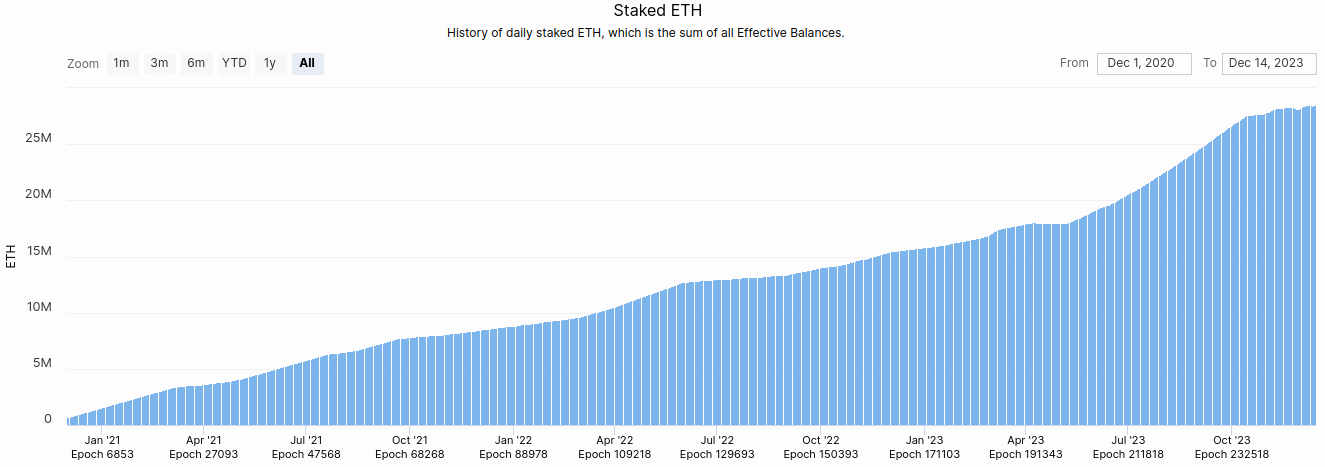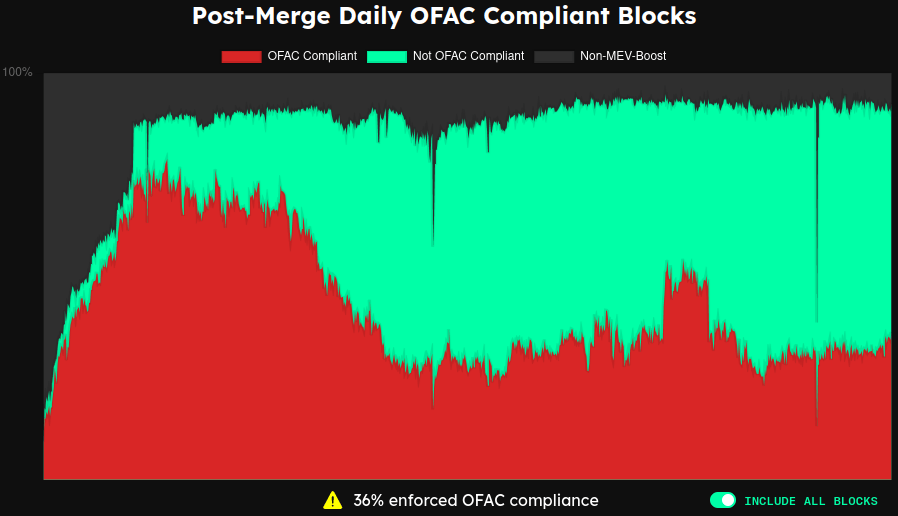Launched in 2015, blockchain Ethereum has democratized the concept of smart contract. Several years of evolution followed during which Ethereum was a breeding ground for innovation. As 2023 draws to a close, it’s a good time to look back on the year of Ethereum.
Before getting to the heart of the matter, let’s come back to the state of Ethereum before the transition to 2023. Thus, September 2022 was marked by a major update of Ethereum, namely The Merge.
As a reminder, The Merge update has come modify the Ethereum consensus system. So this update has finalized the transition from Proof of Work to Proof of Stake.
This notably brought changes in terms of architecture. Now, Ethereum is a two-layer blockchain:
However, at the end of 2022, a major piece is still missing from Proof of Stake: withdrawals. Indeed, as 2023 approaches, validators were not still not able to remove the collateral from their node, or even the increased rewards.
Shortly after The Merge, a worrying phenomenon was observed on Ethereum. In fact, the majority of transactions validated on the network were OFAC compliantnamely that they respected the recommendations of theOffice of Foreign Assets Control the United States. A situation that Morgan then explained perfectly to us.
In practice, this censorship occurred after the addition of Tornado Cash to the US Treasury blacklist. A dramatic censorship situation on a blockchain. All players in the ecosystem agreed that we had to fight against this censorship in 2023.
Now that we have taken a brief look at the situation of Ethereum at the end of 2022, let’s see how it has evolved in 2023.
The year 2023 of Ethereum
As we just covered, 2023 was a year full of challenges and procrastination on Ethereum. After the numerous postponements of The Merge and the move to Proof of Stake, user expectations were at their highest.
Shanghai: the release of ETH
The year started off pretty well for Ethereum with the deployment in April of the long-awaited Shanghai update. This is the most anticipated update, because it is the one that opens the possibility of withdrawing ETH deposited in staking.
In addition, it also allowed validators to recover the rewards so far accumulated by their node. At that time, many Ethereum detractors were predicting a massive ETH flight.
Finally, since the opening of withdrawals, 6.2 million ETH was withdrawn. However, these withdrawals were largely offset by massive deposits. Thus, since the opening of the consensus layer, the number of ETH deposited in staking has continued to increase. A victory for Ethereum against its detractors.

2023: the year of layers 2 on Ethereum
In 2022, Ethereum has changed the direction of its roadmap, particularly with regard to the scalability problem. So, the developers took the decision to orient the network towards a so-called “rollup-centric” paradigm, namely that scalability would come through the advent of rollups.
As a reminder, the rollups are second layer solutions of Ethereum. The latter offer an ecosystem similar to Ethereum with an implementation of EVM, while having much better performance.
You will no doubt have noticed, the year 2023 will have been marked by the massive growth of layers 2 on Ethereum. So, in one year, the TVL of L2s has been multiplied by more than 3 going from just over $4 billion to almost $16 billion.


At the head of this ecosystem, we find 3 solutions that have marked 2023:
As the L2Beat site shows, layers 2 allow Ethereum to process approximately 5 times more transactions. Thus, Ethereum processes on average around ten transactions per second, while all the L2s which evolve in parallel can process more than forty.
Note that Layer 2 of the Optimistic Rollup type remains the most used L2. For their part, zk-Rollups have still evolved significantly in 2023 with the launch of several mainnets, such as that of zkSync Era.
Lido threatens Ethereum
In parallel with the transition to Proof of Stake, numerous so-called protocols Liquid Staking emerged on Ethereum. As a reminder, these protocols allow you to participate in Ethereum staking, without having to block your ETH in a validator. Indeed, the Lido protocol will issue a token which represents the ETH deposit, which can then be exchanged on a DEX or used in DeFi. This makes the staking market on Ethereum much more liquid..
However, the Lido’s success has been such that it begins to threaten Ethereum. Indeed, the protocol Lido currently accounts for 31.7% of all ETH deposited in staking. A dangerous situation, because it could lead to excessive centralization around the protocol. This would make Lido a single point of failure in the Ethereum system.


Let’s hope that in 2024 new solutions will restore this growing monopoly situation.
Fight against censorship
As we discussed previously, alongside the Tornado Cash affair, Ethereum saw significant censorship in 2022. Fortunately, this appears to have been resolved in 2023.
So, just over 30% of blocks produced on Ethereum apply OFAC recommendations. This represents a decrease by more than half compared to 2022where up to 70% of transactions were OFAC compiling.


This reduction was notably made possible by FlashBot. In fact, the company has little by little published its source code in an open manner. Consequently, new operators based outside the USA have been able to start their activity. This has significantly reduced the dependence of the Ethereum network on block propose And producer block North Americans.
Millions of dollars lost in hacks
Despite these successful developments and transitions, 2023 will not have been all rosy for Ethereum though. Indeed, the network was once again the prey to hackers and other scammers.
Thus, the year 2023 will not have escaped attacks on DeFi protocols, particularly on Ethereum.
Among the most notable attacks, we have the hack of Euler Finance last March with nearly $200 million stolen. A vulnerability was present in the rounding of amounts.
We can also cite the Curve Finance hack last July and its $60 million stolen. The protocol was subject to a flaw of type reentry.
Or even Kyber Network which had more than $50 million stolen at the end of November.
These are just the biggest cases of hacks. Unfortunately, there are dozens of other cases, such as Sturdy Finance, Conic Finance or Swing.
Thus, despite the growth and constant innovation of DeFi, smart contracts remain frequently subject to flaws and attacks. Hopefully this hack trend can finally be curbed in 2024.
Future developments in 2024
As we have just seen, 2023 has been a year full of evolution and innovation on Ethereum.
Obviously, the developers are not going to relax their efforts in 2024 and many updates are already planned.
Thus, at First quarter of 2024, Cancun-Deneb update expected to be deployed on the Ethereum mainnet. This update will notably introduce EIP-4844, also known as “Proto-Danksharding”.
Without going into detail, this update aims to create a new type of transaction dedicated to on-chain data storage. This development will allow, among other things, a clear improvement in the performance of layers 2 as well as a reduction in transaction costs on these second layer solutions.
However, no exact date has yet been announced. However, feedback from developers during the various devnets seems positive so far.
In any case, the year 2024 also promises many developments on Ethereum. Perhaps it will also be the year of a new bull run and why not new records at the level of ETH price.
